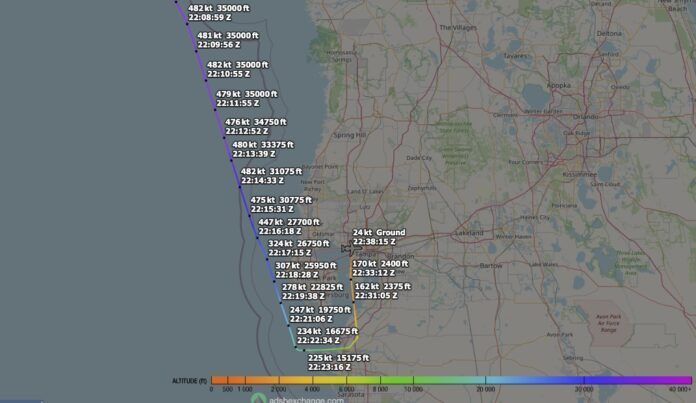Tamarack Aerospace has publicly responded to last week’s emergency landing of a Cessna Citation CJ3 that was modified with the company’s Smartwing active winglet technology. The company cites “external factors” as the likely cause of the left winglet departing the aircraft, adding that its active winglet technology functioned “normally” during the descent and safe landing.
The Tamarack modification enables adding the winglets, which significantly improve rate of climb and range. The modification uses a passive aerodynamic moving surface, similar to an aileron, near the winglet that relieves winglet-induced stress on the spar, obviating the need for strengthening the spar. The CJ3 was on a flight from Walnut Ridge, Arkansas, to Tampa, Florida. The landing was recorded by a news helicopter.
According to a Tamarack Aerospace statement, the single pilot (the aircraft’s only occupant) experienced “bumps” at 27,000 feet on descent from 35,000 feet to landing at Tampa International Airport (KTPA) on the early evening of March 30. The pilot then noticed that the winglet was missing and declared an emergency. “He followed standard procedure and slowed the aircraft while making a smooth approach and landing,” according to the statement.
Data posted by ADS-B Exchange shows the Citation beginning its descent from 35,000 feet off the west coast of Florida, taking about four minutes to reach 27,000 feet, where the separation reportedly occurred. The descent rate was normal for a CJ3 at approximately 1,925 feet per minute. The rest of the descent to landing about 20 minutes later also shows normal performance. According to Tamarack, the modified Citation is one of three active-winglet-equipped Citations operated by the owner, who asked not to be identified. “The owner and pilot are talking with authorities, and further investigation will be conducted to assess possible damage to other areas of the aircraft before repairing the left wingtip and returning the aircraft to service,” said Tamarack.
Tamarack Aerospace Group President Jacob Klinginsmith said, “We are obviously grateful that nobody was injured in this strange incident. We’re still investigating, but it appears that external factors caused the winglet to be ripped from the aircraft.” He added, “During certification, we successfully flight tested a ‘one winglet removed’ scenario simulating a bird strike, lightning strike or any other abnormal event to the winglet, so we would expect the plane to handle as well as the pilot described.”
Update:
After reviewing the NTSB Preliminary Report, Tamarack issued a statement including the following information:
“The pilot reported that while in a cruise descent at an altitude of about 30,000 ft, at about 18:15 ET, he felt two ‘big jolts,’ and saw the left wingtip was missing…Examination of the airplane revealed that the left wing extension and the left aileron were substantially damaged in the event; and the left wing extension, Tamarack winglet, and Tamarack Active Camber Surfaces (TACS) were all missing. The remaining components of the Tamarack system were documented and examined on the airplane and no system anomalies were noted.”



































A bird strike at 27,000′ over Florida! Really? I do hate it when folks “spin” the facts.
You should re-read the paragraph. No one has suggested it was a bird.
John W is correct – the bird strike was in reference to testing. But who knows? I hear some larger species have been flying very high to take advantage of the north-flowing air currents to aid in migration. They can be identified by the tiny oxygen packs on their back.
As an aside, the highest recorded altitude for a bird strike is 37,000 feet.
Though as others have written, that is not being claimed here.
Watched the video and other than the missing winglet the approach and landing were uneventful. Something struck the aircraft at altitude. As a retired A&P I’d be curious to see the damage and note any possible blood and feathers.
“Smartwing active winglet technology” uuuuuuu! LOL Hey! ask Burt Rutan to fix the
problem. He too had eject-able wiglets on his Voyager! LOL “The Tamarack modification enables adding the winglets, which significantly improve rate of climb and range.” uuuuuuuu! of course! LOL
You ok Lewis?
I think Lewis M.’s “u” key is sticking – maybe along with a forgotten macro for randomly inserting LOL’s,
“Bumps” at 27,000 feet. Either really severe bumps or UFO contact, maybe a Chinese spy balloon.
It’s not the bird that causes the damage, its the supplement oxygen they carry when they fly that high.